In this article, you will learn what is Air conditioning system with its working principle and classification or types of air conditioning systems.
Download the PDF file at the end of this article.
What is an Air Conditioning?
Nowadays, the air conditioning system is widely used in both domestic and commercial environments. The air conditioning is sometimes also known as air cooling.
It is the process of removing heat and moisture from inside the occupied space, to improve the comfort of occupants. In many cases, this process is used to create an interior environment that is more comfortable for people.
Typically, air conditioning is used to maintain a cool atmosphere in warm weather by controlling humidity, ventilation, and temperature.
Despite the fact that air conditioners vary from model to model, they can be found in any size from small units to massive units that can cool an entire building.
The typical air conditioning system is made up of many parts, some of which are listed below.
Check this out: What is a Heat Exchanger and how does it work?
Equipment Used in an Air Conditioning System
The following are the main components you will typically find in any air conditioning system::
#1 Circulation Fan
The primary function of this fan is to move air to and from the room.
#2 Air Conditioning Unit
It is a unit, which consists of cooling and dehumidifying processes for summer air conditioning or heating and humidification processes for winter air conditioning.
#3 Supply Duct
It directs the conditioned air from the circulating fan to the space to be air-conditioned at the proper point.
#4 Supply Outlets
Supply outlets are nothing but grills, which distribute the conditioned air evenly in the room.
#5 Return Outlets
Return outlets are the surface openings in a room that allow the air from the room to enter the return duct.
#6 Filters
The main function of the filters is to remove dust, dirt, and other harmful bacteria from the air.
We now have a clear understanding of the components and their function of the air conditioning system. Let’s discuss the air conditioning system’s working principle.
You might like: Different Types of Evaporators and Their Applications
Air Conditioner Working Principle
An air conditioner continuously draws the air from an indoor space to be cooled, cools it by the refrigeration principles, and discharges it back into the same indoor space that needs to be cooled.
This continuous cyclic process of drawl, cooling, and recalculation of the cooled air keep the indoor space cool at the required lower temperature needed for comfort cooling or industrial cooling purpose. When you switch the air conditioner on, the thermostat control sends 120V of alternating current to the compressor and the fan motor.
This compressor acts as a pump compressing the refrigerant in gas form into the condenser coils. It is located at the back of the unit. Where the gas is condensed into a hot liquid. The condenser coils dissipate the heat as the liquid travels through them.
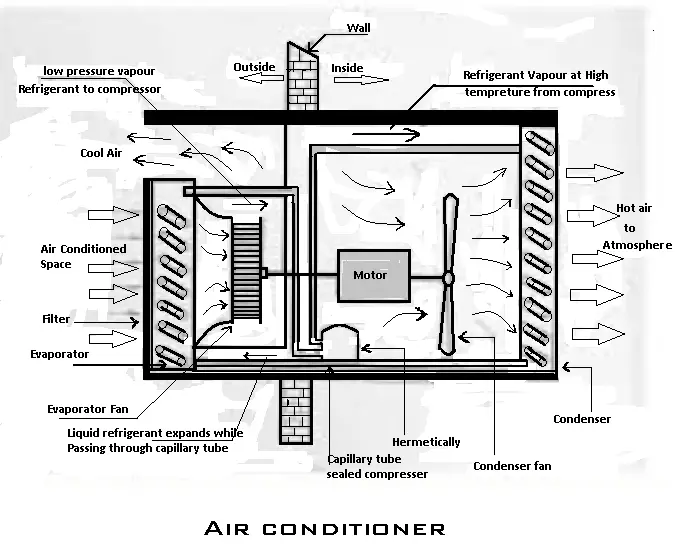
Working
The working of an air conditioning system is pretty straightforward. Once the liquid refrigerant has passed through the condenser coils and the capillary tube it undergoes expansion. The liquid refrigerant passes through the evaporator coils. It travels to the evaporator coils located near the front of the unit.
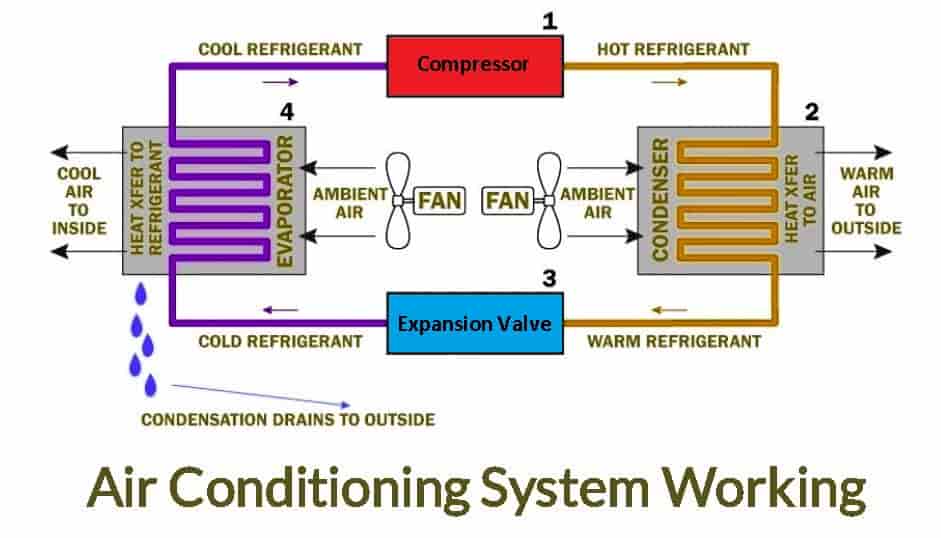
As the refrigerant liquid enters these coils it expands into a gas which makes the coils cold. The gas flows through the coils to a suction line, attached to the compressor converts the gas back into a liquid and the cooling cycle continues.
At the same time, the fan motor rotates a blower wheel which draws in air to be cooled by the evaporator coils before recirculating it back into the room. It also operates the condenser fan blade which blows outside air through the condenser coils to cool them.
The air temperature is regulated by the thermostat control depending on the model. The control may be a thermostat switch and sensing bulb assembly or an electronic control board that works with a sensor. The sensing bulb or electronic sensor is clipped to the front of the evaporator coils to monitor the temperature of the air entering the coils.
Once the room has sufficiently cooled the thermostat control shuts off the voltage to the compressor. Some models that use an event can operate the fan motor only to draw in cool air at night.
However, when the appliance is actively cooling the air the vent must be closed for the system to work properly. A slinger ring on the condenser fan blade picks up collected water at the bottom and sprays it onto the condenser coils to help the coils dissipate the heat.
To prevent the water from dripping into the room the appliance should be tilted back slightly when is installed.
Types of Air Conditioning System
The different types of air conditioning systems depend on a number of factors, including the purpose, season, and equipment. A few of these are described below.
#1 According To The Purpose
a) Comfort Air Conditioning system
In these types of air conditioning system, the air is brought to the required dry bulb temperature and relative humidity for human health, comfort, and efficiency. If sufficient data of the required is not available, then it is assumed to be 21°C dry bulb temperature and 50% relative humidity.
Applications: In homes, offices, shops, restaurants, theatres, hospitals, schools, etc., use air-conditioning systems to give comfort to people.
b) Industrial Air Conditioning System
In these types of air conditioning system, the inside dry bulb temperature and relative humidity of the air is kept constant for the working of the machine and for the manufacturing process.
Applications: In textile mills, Paper mills, Machine part manufacturing plants, Toolroom, Photographic, etc. are using this type of air-conditioning system.
#2 According To A Season of The Year
1. Winter Air Conditioning System
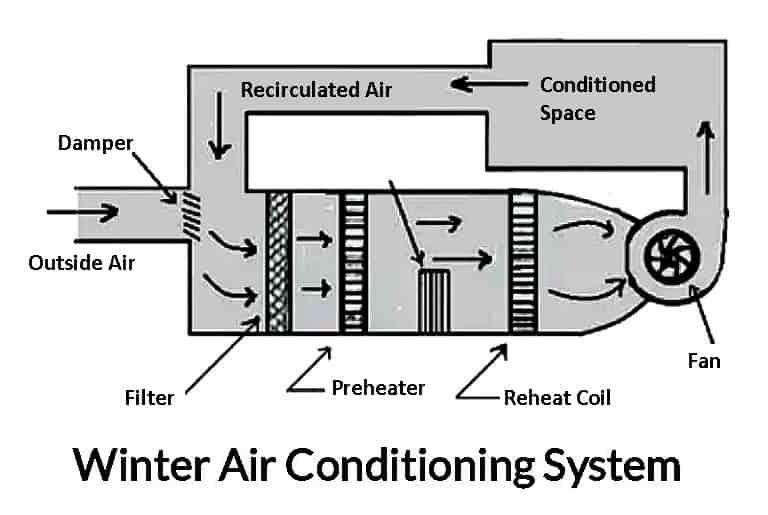
Air conditioner working principle In a winter air conditioning system, the air is burnt and heated, which is generally followed by humidification. Take a look at the schematic for the system, which is arranged below.
The outside air flows through a damper and mixes with the recirculated air. The mixed air passes through a filter to remove the dirt, dust, and impurities.
The air now passes through a preheat coil to prevent the possible freezing of water and to control the evaporation of water in the humidities. After that, the air is made to pass through a reheat coil to bring the air to the designed dry bulb temperature.
Now, the conditioned air is supplied to the conditioned space by a fan. From the conditioned space, a part of the air is exhausted into the atmosphere by the exhaust fans. The remaining part of the used air is again conditioned and this will repeat again and again.
Benefits of Winter Air Conditioning
People spend a lot of time indoors in close quarters during the winter, especially during the Christmas holiday season. This system helps by keeping clean air in the house, free of dust and other pollutants, and it can even prevent the spread of germs.
Pets will no longer make allergy sufferers sneeze or dab at their watering eyes, making them feel more comfortable at your house.
2. Summer Air Conditioning System
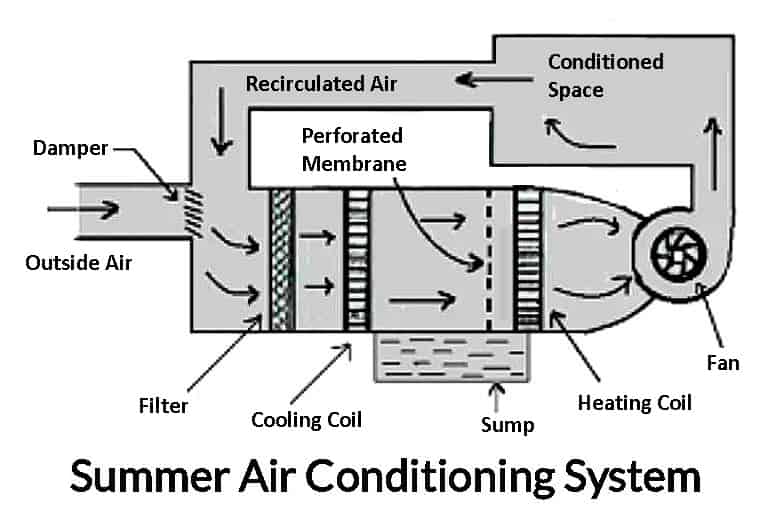
Air conditioner working principle in summer air conditioning system. In this system, the air is cooled and generally dehumidified. A Schematic for a typical summer air conditioning system is arranged.
The outside air flows through the damper and is mixed with recirculated air (which is obtained from the conditioned space). The mixed air passes through a filter to remove the dirt, dust, and impurities.
The air now passes through a cooling coil. The coil has a temperature much below the required dry bulb temperature of the air in the conditioned space.
The cooled air passes through a perforated membrane and loses its moisture in the condensed form which is collected in the sump. After that, the air is made to pass through a heating coil which heats the air slowly.
This is done to bring the air to the designed dry bulb temperature and relative humidity. Now the conditioned air is supplied to the conditioned space by a fan. From conditioned space, a part of the used air is rejected to the atmosphere by the exhaust fan. The remaining air is again conditioned and this is repeated again and again.
The outside air is sucked and made to mix with recirculated air to make for the loss of conditioned air through the exhaust fan from the conditioned space.
Benefits of Summer Air Conditioning System
Any room in your house can be kept at the ideal temperature thanks to these air conditioners. During the hot summer nights, bedrooms can be kept cool, allowing you to sleep peacefully and comfortably.
By installing these types of ACs, you can keep your windows and doors closed, keeping out nuisance insects.
3. Year-Round Air Conditioning System
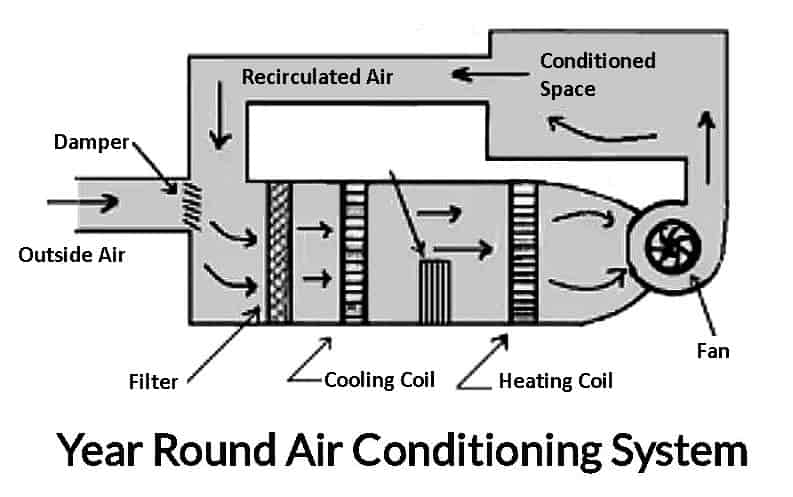
In a year-round air conditioning system, it should have equipment for both summer and winter air conditioning. Schematic for a modern summer year-round air conditioning is arranged.
Air conditioner working principle In year-round air conditioning system. In this, the outside air flows through the damper and mixes with the recirculated air. The mixed air passes through a filter to remove dirt, dust, and impurities.
In the summer air conditioning system, the cooling operates to cool the air to the desired valve. The dehumidification is obtained by operating the cooling coil at a lower temperature than the dew point temperature.
In the winter air conditioning system, the cooling coil is made inoperative and the heating coil operates to heat the air. The spray-type humidifier is also used in the dry season to humidify the air.
Benefits of Year-Round Air Conditioning System
A year-round air conditioner system combines heating and cooling. Since it operates in both the winter and summer, it is known as a year-round air conditioner.
This system will meet your cooling and heating needs, so you can save money by purchasing it. This system’s initial cost is high, but because it functions in both the summer and the winter, its ongoing costs will be low.
#3 According To The Arrangement of Equipment
1. Unitary Air Conditioning System
In the unitary air conditioning system, the assembled air conditioner is installed in or adjacent to the space to be conditioned.
Unitary systems, the common type of one-room conditioners, sit in a window or wall opening, with interior controls. Interior air is cooled as a fan blows it over the evaporator.
The exterior air is heated as a second fan blows it over the conditioner. In this process, heat is supplied from the room and discharged to the environment.
A large house or building may have several such units, permitting each room to be cooled separately.
The unitary air conditioning systems are of the following two types,
- Window unit
- Vertical packed units or PTAC systems
a) Window Unit
These types of conditioners have a small capacity of 1TR to 3TR and are mentioned through a window or wall. They are employed to condition the air of one room only. If the room is bigger in size, then two or more units are used.
b) Vertical Packed Units or PTAC systems
This types of air conditioning system is bigger in the capacity of 5 to 20TR and is adjacent to the space to be conditioned. This unit is very useful for conditioning the air of a restaurant, bank, or small office. PTAC systems are also known as wall-split air conditioning systems or ductless systems.
These PTAC systems which are widely used in hotels have two separate units, the evaporative unit on the interior and the condensing unit on the exterior, with tubing passing through the wall and connecting them together. This minimizes the interior system footprint and allows each room to be adjacent independently.
PTAC system may be adapted to provide heating in cold weather, either directly by using an electric strip, gas, or other heaters or by reversing the refrigerant flow to heat the interior and draw heat from the exterior air, converting the air into a heat pump.
While room air conditioning provides maximum flexibility when cooling rooms it is generally more expensive than a central air conditioning system.
2. Central Air Conditioning System
It is the most important type of air conditioning system, it is used when the required cooling capacity is 25TR or more. It is used when the airflow is more than 300 m³/min or different zones in a building are to be air-conditioned.
Application of Air-Conditioning
Following are the applications of the Air Conditioning System:
- Using air-conditioners is common in food cooking and processing areas. Used in hospital operating theatres to provide comfortable conditions to patients. And many more industries like Textile, Printing, Photographic, and much more.
- The air-conditioning system is used as a commercial purpose for a human being. For example, in Theatres, Departmental store-room, etc.
- Many transport vehicles use air-conditioning systems such as cars, trains, aircraft, ships, etc. This provides a comfortable condition for the passengers.
- The air-conditioning system used in Television-centres, Computer centers, and museums for a special purpose.
Download Pdf of this article
Conclusion
So now, we hope that we have clear all your doubts about the Air conditioning system. If you have still any doubts about the “Types of Air conditioning system” you can contact us or ask in the comments.
That’s it thanks for reading. If you like our article then please share it with your friends.
Subscribe to our newsletter to get information of our latest posts.
You may be interested in reading this article:

I love learning about different types of air conditioning systems!
That’s awesome! 😄
This is very useful article
Thank you.
Thank you so much for your brilliant post. I am waiting to read your next post.
You’re welcome.
It is a good article.
Thank you 🙂
It refers to a number of conditions in which the majority of people feel comfortable.